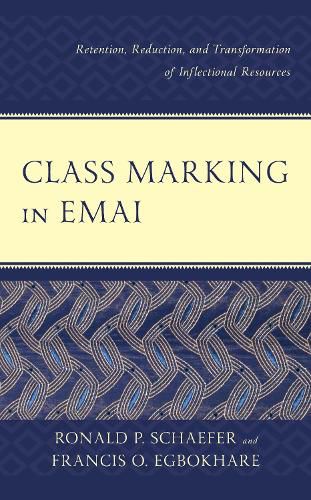Readings Newsletter
Become a Readings Member to make your shopping experience even easier.
Sign in or sign up for free!
You’re not far away from qualifying for FREE standard shipping within Australia
You’ve qualified for FREE standard shipping within Australia
The cart is loading…






Class Marking in Emai: Retention, Reduction, and Transformation of Inflectional Resources examines the retention, reduction, and transformation of inflectional resources pertaining to noun class in Emai, an Edoid language of south-central Nigeria. In the larger context of Benue Congo studies, in which some members of West Benue Congo are characterized by non-inflection and radical whereas classic Bantu and many of its East Benue Congo relatives show a non-analytic, agglutinative nature. Schaefer and Egbokhare demonstrate that in contrast to its Bantu relations, Emai retains form class prefixes on a relatively small group of nouns that distribute across eleven declension sets. Prefix addition rather than prefix alternation arises when ideophonic adverbials become syntactically displaced due to information structure and when Emai borrows lexical items from other languages.
Reduction is evident in two primary domains: prefixes that alternate to express form class and grammatical number, and gender classes. Finally, transformation is evident in tonal, nominal and pronominal domains. Putting Emai and its noun class system into a broader cultural and archaeological context of historical language change, this book explores what it means to be a Benue Congo language with a reduced inflectional system.
$9.00 standard shipping within Australia
FREE standard shipping within Australia for orders over $100.00
Express & International shipping calculated at checkout
Class Marking in Emai: Retention, Reduction, and Transformation of Inflectional Resources examines the retention, reduction, and transformation of inflectional resources pertaining to noun class in Emai, an Edoid language of south-central Nigeria. In the larger context of Benue Congo studies, in which some members of West Benue Congo are characterized by non-inflection and radical whereas classic Bantu and many of its East Benue Congo relatives show a non-analytic, agglutinative nature. Schaefer and Egbokhare demonstrate that in contrast to its Bantu relations, Emai retains form class prefixes on a relatively small group of nouns that distribute across eleven declension sets. Prefix addition rather than prefix alternation arises when ideophonic adverbials become syntactically displaced due to information structure and when Emai borrows lexical items from other languages.
Reduction is evident in two primary domains: prefixes that alternate to express form class and grammatical number, and gender classes. Finally, transformation is evident in tonal, nominal and pronominal domains. Putting Emai and its noun class system into a broader cultural and archaeological context of historical language change, this book explores what it means to be a Benue Congo language with a reduced inflectional system.